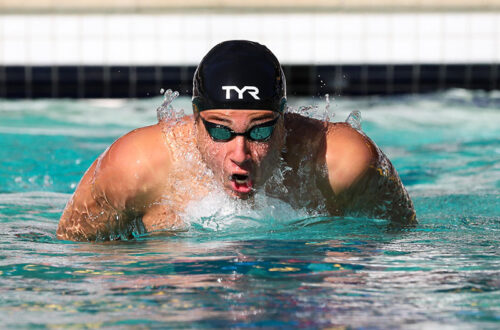
Harraher is the Chief of Neurosurgery at Dominican Hospital
Dr. Ciara Harraher is running around her front yard on a cool Saturday afternoon in January with 20 nine-year-old boys at her son, Finn’s, birthday party. Directing a nerf war is no easy task.
“Wrangling the boys was like getting an operating room in check! That was so much fun. Finn envisioned doing his nerf war, so I had to come through with it,” said Harraher.
Dr. Harraher’s professional resume is remarkable. She is the Chief of Neurosurgery at Dominican Hospital and heads the Stanford Neurosurgery Outreach Clinic. She also teaches Principles of Medicine to Stanford MD students. She received her medical degree from McMaster University in Hamilton, Canada, a Master of Public Health from Harvard, completed residence at Dalhousie University in Halifax, Canada and fellowships at Stanford University.
She also has leadership positions on numerous boards, advisory committees and professional organizations. Dr. Harraher was also a professional dancer who toured the world, but at home, she is Mom.
Her daughter, Gemma McDonnell, 11, says. “My mom and I really like ballet. She danced when she was a kid, and I dance now, so we share, and talk about dance a lot. We go to the ballet, and we share a lot of other things that we like including shopping”.
“We do biking, exercising and running, a lot of running, and she watches movies with me,” said Finn McDonnell, 9.
Born in Toronto, Dr. Harraher learned hard work and dedication from a young age from her passion for dance. After high school, she went on to study neuroscience and philosophy. Upon graduating, she moved to Europe, doing contemporary and modern dance professionally in London, and then later working on a British Cruise line.
After an injury sidetracked her dancing career she applied to medical school where only 6 percent of neurosurgeons are female, and many people tried to dissuade her from the profession, but she didn’t listen, and took on this new challenge.
Professors even tried to persuade her to choose a different specialty, saying she wouldn’t be able to have a family life as a neurosurgeon, she would never get married, wouldn’t be able to have kids, and life would be difficult.
After meeting her husband, Mike McDonnell, in her second year of residency, she realized a family and life being a neurosurgeon could blend. McDonnell, a professional chef, has been her biggest supporter and when she voiced concerns about not being able to have enough time for any kids in the future he replied, “I’ll be there.” Her former professor was wrong, she could have kids and a family life.
Today, Dr. Harraher often performs multiple surgeries a day, of which many are lifesaving procedures, in Santa Cruz, and sees patients with some of the most serious health issues in our county. Stanford has an agreement with Dominican Hospital, to provide neurosurgery services, and Dr. Harraher has served as the chief of neurosurgery since 2014. Having someone with her expertise living and working in our county is beneficial to the community.
In the following interview Dr. Harraher explains her path to neurosurgery, a typical day in her life, lack of diversity in her field, work/life balance, and her family. She is a Healthcare Hero of Santa Cruz County and serves the critical medical needs of the community.
Your passion growing up was dance, how did you get interested in neuroscience?
Dancing had always been my main activity, on a serious level, throughout my childhood and adolescence. I wanted to do professional dance right out of high school, but my parents, in their wisdom, felt that I could dance while I was at college and still get my undergraduate degree. Towards the end of high school, I became quite interested in biology, specifically neurobiology of the brain. When I went to University, I studied neuroscience and philosophy. I always had a hard time between science and the arts, I loved both and I think medicine is really a big blend of art and science to be honest, and it was a really good fit for me. I got advice towards the end of college that I would be good at medicine, because I was good with people.
How did you decide to go into surgery?
I had a friend who wanted to be a surgeon and we were very alike. She convinced me to do surgery as an elective. My friend said, “You’re a dancer, you can perform under pressure, and you stay pretty cool.” Following instructions, working hard, performing under pressure and doing the same thing over and over again – it’s like surgery. To this day, I can take a deep breath because I know what I’m doing. I have my little area of work, I’m going to do what I need to do, and I’m going to get it done.
Surgery and dance are similar, and I like that. There is some aspect of performance. There are lights, there is procedure, there are things you have to do every time and ritual – and I liked the element of pressure. I’m good under pressure, so it’s okay that I need to do something quickly and I need to get it done now!
What does a typical day look like for you?
I try and get up in the morning at 5:30 or 6 am, before the kids and the animals and everyone gets up. I do yoga for an hour. It’s good in a lot of ways for strength and fitness, but it’s also good mentally to center myself before the day stars, which can get crazy. Once I finish yoga, we get the kids out to school, and then I leave somewhere between 7 or 8:30 am.
On clinic days, I have somewhere between 15-20 patients, there’s a combination of new and follow up patients, and I also have patients in the hospital that I’m going to see as well, in between patients. I take calls from Dominican Hospital frequently, which means I’m getting calls from the Emergency Room with patients with neurological issues that need to be seen. I’m the only full-time neurosurgeon in Santa Cruz, and I’ve been the chief of the department since 2014.
On operating days, one to three days a week, it’s a combination between general neurosurgery cases, things like spine surgery, neck and back, degenerative spine disease conditions, tumors, trauma and brain bleeds. I also do a little peripheral nerve like carpal tunnel as well.
Female Neurosurgeons represent only 12% of neurosurgeons in the U.S. and Canada, and only 6 percent at the full professor level. Why are women significantly underrepresented in neurosurgery?
Many men told me not to do it. It would be too difficult a lifestyle. It would be too stressful. It would be too hard to have a family. I would never get married. I’d never have kids. I could have a much easier life if I did something else. A lot has changed in 20 years, but I think there is still an element where people tell women not to do things. Also, women don’t see their mentors in neurosurgery, so they don’t pick it.
Does a work/life balance exist for women?
The thing about balance is you don’t have it all the time. There are going to be times when you don’t have a lot of it, and times you can make up for it. Quality time versus quantity is important.
Talk to your kids. I do this when I’m in the car with them. We have meals together. Meals are so important. I really try to be home for dinner, even if it means going back to work later. It doesn’t always have to be a lot of time, it just has to be quality time. Being present is important.
You work in such a demanding field. How do you manage it all with motherhood?
Having a supportive partner is the key to why I can do this job. A partner who is okay with working outside of normal expected marital roles. Mike, my husband, has always been supportive and proud of me. He has never thought of my job as a burden, he is proud of what I do. Also, women are always expected to be the one the school always calls. Just change the number on the form. They can call dad too. There is no way I could do everything alone. It takes a village.






